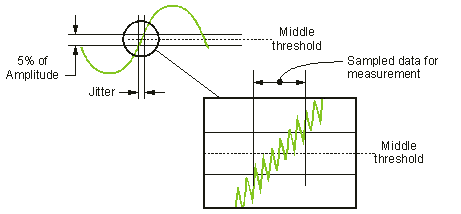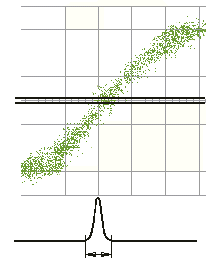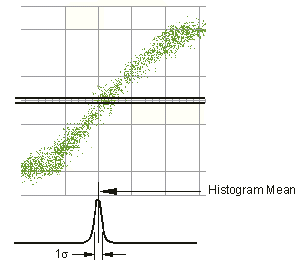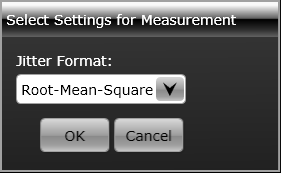Jitter

 The Oscilloscope mode Jitter is a measure of the time variances of the rising or falling edges of a pulse waveform at the middle threshold. When a jitter measurement is selected, the measurement database is enabled. This is the only Oscilloscope mode measurement that uses a database. Because a database is used multiple waveform acquisitions must be acquired to populate the database before the measurement can be made.
The Oscilloscope mode Jitter is a measure of the time variances of the rising or falling edges of a pulse waveform at the middle threshold. When a jitter measurement is selected, the measurement database is enabled. This is the only Oscilloscope mode measurement that uses a database. Because a database is used multiple waveform acquisitions must be acquired to populate the database before the measurement can be made.
One annotation label is placed at the start of the jitter and one on the end of the jitter. The waveform data that is sampled is accumulated in the measurement database. In order to view the data from the measurement database, you must select the color grade (or gray scale) display persistence mode. However, it is not necessary to view the data from the measurement database in order to make jitter measurement. When in the other persistence modes, the most recent acquired data is used for the measurement results.
| Results Message | Do this … |
|---|---|
| Edge? |
|
| Cross? |
|
| Signal Type? |
|
The Jitterp-p and Jitterrms measurements can not be made on a measurement region.
If the Enhanced Jitter Analysis option is installed, take a look at the powerful Jitter Mode feature. Jitter Mode quickly separates jitter into its components and displays measurement results using tables and graphs.
Click Clear on the menu bar to clear the measurement database and accumulate new data. You can then view an accurate representation of the data used for the jitter measurement.
To measure jitter, the middle threshold is located, and a measurement window is placed horizontally through the middle threshold. The measurement window is narrow in amplitude. A time histogram is generated, and the histogram's mean value establishes the center of the measurement window. The amount of jitter on the waveform is determined by the amount of data that falls within the measurement window.

The default for the middle threshold is the 50% level. The lower and upper threshold levels do not directly affect the jitter measurement. However, the lower and upper threshold levels are used to determine whether or not a waveform edge is valid for the measurement.
The top and base of the waveform must be on the display screen in order for the instrument to calculate jitter.
Jitter is measured and displayed in either of the following formats.
- Jitterp-p is equal to the full width of the histogram at the middle threshold.

- Jitterrms is defined as 1σ (standard deviation) from the histogram mean

Configurable Measurement Parameters
This measurement is affected by the following settings (click Measure > Configure Base Measurements):
- Top-Base Definition tab
- Thresholds tab
To measure
- Select Oscilloscope Mode.
- Click the toolbar's Time tab.
- Click the toolbar's More buttons to locate the Jitter button.
- Click the button and select the jitter format: Root-Mean-Square or Peak-to-Peak. If more than one waveform is displayed, select which waveform you want to use to make the measurement.

SCPI Command
:MEASure:OSCilloscope:JITTer